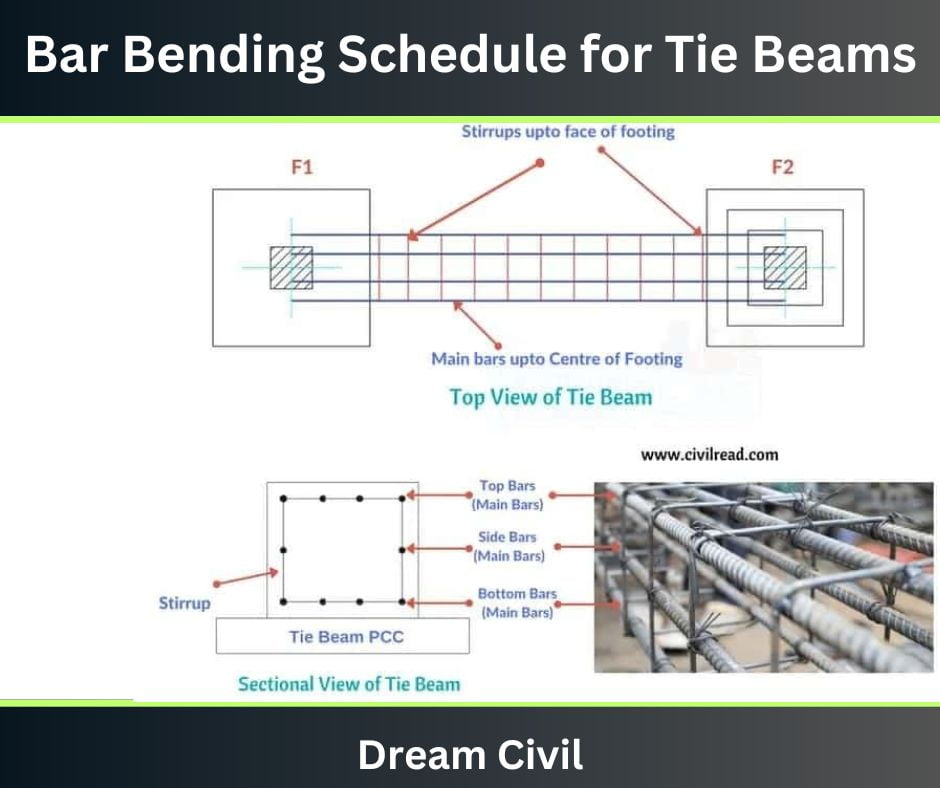Table of Contents
A tie beam that attaches two or more columns or rafters in a roof or roof truss or in any height above floor level to prepare the entire structure stiffer and balance at the foundation level is called a tie beam.
Tie beams are mainly given at the roof truss and floor level and a plinth. They cannot convey any vertical load such as walls etc.
The tie beams are used not kept to carry the slab load but to work as a stiffener to the columns and thereby decrease the long column effect.
Sometimes it also works as a damp-proof course at the plinth level and as a divider for ventilators and doors when kept at the lintel level.
1. Tie Beam Details
When the roof height is more than the usual height of the structure, then these types of beams are kept.
They behave as a length breakers in the columns.
It joins two or more columns to reduce their effective length and decrease their slenderness ratio.

2. Bar Bending Schedule for Tie Beams
The bar bending schedule is as follows:
a. The aim of the bar bending schedule is to know the amount of reinforcement important for the building.
b. Bar Bending Schedule for footings is a major role in collecting ideas on the tie beam/strap beam reinforcement in the substructure.
c. Tie Beam connects the two footings in the substructure. If the two footings stay in a similar line, the tie beam should be managed.
d. Strap Beam alias inclined beam has a similarity with tie-beam, but it connects two footings at a specific angle. A strap beam is kept if two footings stay at various levels.
e. The tie beam/ Strap beam is particularly located among pile caps and shallow foundations. Their major aim is to force all shallow foundations or pile caps to roughly get similar settlements.
f. The horizontal bars which attach one footing to the other footing, belong to the main bars, and the vertical bars are known as stirrups. Stirrups facilitate framing the major bars in an accurate position.

3. Tie Beam Reinforcement
The following points should be remembered to realize the reinforcement in tie beams:- Main Bars (Top bar, Bottom bar, Sidebar) are attached to the center of one footing to the center of another footing. Stirrups are provided from one face of the footing to another front of the footing.

4. Ties in Column
The good use of column ties for preparing a perfect structural design. At first, straightening of the rods is needed for preparing ties to maintain accurate diameters. The minimum length of the tie rods should not be under 10 mm.
On the basis of the measurements mentioned in the drawing, the rods should be cut with proper support and bent cautiously; otherwise, it gets damaged.
For continuing good specification as well as gapping of the ties, we are required to come after the design engineers and obey the BNBC, ACI, and ASTM codes.

5. Difference between Plinth and Tie Beam
The difference between a plinth and a tie-beam is as follows:
| Plinth Beam | Tie Beam |
| It generally refers to the horizontal structural element that holds all the columns intact with the walls. | It generally refers to the horizontal structural element that tends to reduce the slenderness ratio of the columns in the structure and thus stiffen the entire structure as a whole. |
| It is provided at the plinth level of the building. ( It is also known as the upper tie beam. ) | It is located at the plinth level or in places other than the plinth level. |
| It retains the underlying soil as well as acts as a medium to distribute the soil evenly to the ground below. | It helps to prevent the buckling and failure of the columns in the structure. |
6. References1. Content Filter & Authenticity Checking Team, Dream Civil International (Our team checks every content & detail to maintain quality.) |
| Read Also: Column Size in Different Countries |

